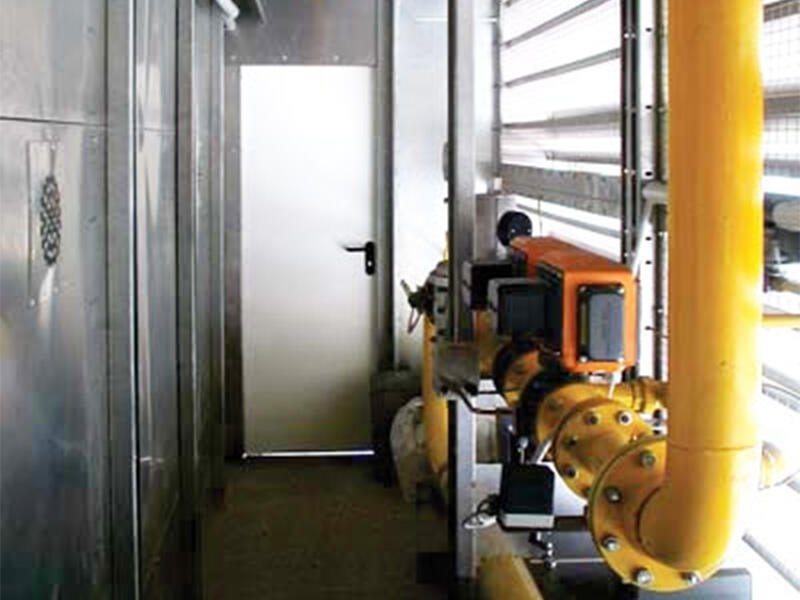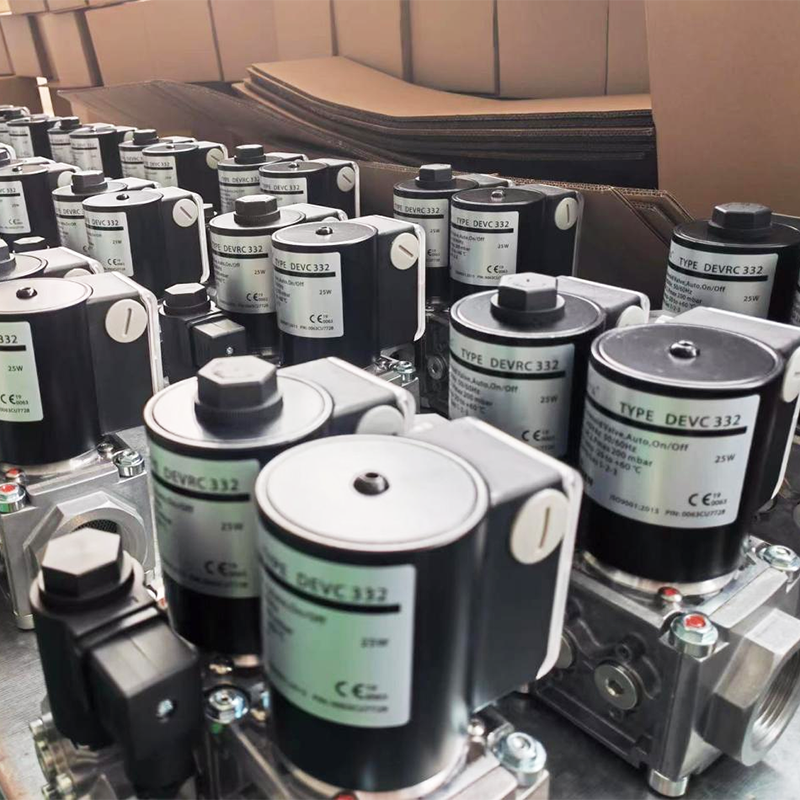Direct-Acting Solenoid Valves: Compact Design for Low-Pressure Applications
Direct acting solenoid valves work when electromagnetic force is applied straight to the valve itself, which gives them pretty fast reaction times. Because of this design, they're really good for situations where pressure isn't too high, like in water dispensers or some hydraulic setups where there just isn't much room to install bigger equipment. Most models come either as 2 way or 3 way versions, something that lets engineers fit them into all sorts of different circuit arrangements without major modifications. The compact size combined with their responsiveness explains why so many industrial systems still rely on these types of valves despite newer alternatives being available.
Pilot-Operated Solenoid Valves: Ideal for High-Pressure Systems
Pilot operated solenoid valves feature a small pilot valve that controls a much larger main valve, making them particularly effective in high pressure environments. The way these valves work lets them manage significant pressure differences across systems, which is why they're so common in manufacturing plants and construction equipment. When looking at energy consumption, pilot operated versions actually save power compared to direct acting alternatives because the solenoid only needs to activate the tiny pilot component rather than moving the whole valve mechanism directly. That's why we see these valves all over oil refineries and gas processing facilities where both safety margins and operational costs matter a lot to plant managers who deal with these systems day in and day out.
High-Flow Solenoid Valves: Managing Large Volumes Efficiently
High flow solenoid valves handle substantial fluid movement and are crucial for systems needing fast flow rates, such as irrigation setups and chemical processing plants. These valves work well because they reduce pressure loss across the system while still allowing maximum throughput. Most models come in two configurations: normally open or normally closed, depending on what the particular application demands. When looking at industrial needs today, many manufacturers turn to these high capacity valves for big operations where controlling large volumes matters most. From agricultural fields to manufacturing facilities, proper valve selection makes all the difference in maintaining consistent operation without wasting resources.
Normally Open vs. Normally Closed Solenoid Valves
Understanding Normally Open (NO) Valve Functionality
When the coil gets power, normally open (NO) solenoid valves let fluid pass through, which is why they work so well in systems needing automatic fluid control. These valves come in handy for things like irrigation setups where water needs to flow on its own without constant monitoring. What makes NO valves stand out is how simple they are built, making installation and maintenance pretty straightforward tasks for most technicians. That simplicity has made these valves popular across different industries. Plus, they react fast enough to keep operations running without much downtime, something plant managers appreciate during production cycles.
Benefits of Normally Closed (NC) Valves in Safety-Critical Systems
Normally closed (NC) solenoid valves stay shut unless electricity runs through them, which actually serves as pretty important safety measure across different industries. Think about what happens during power cuts? These valves become really important then, especially in things like fuel lines or ventilation systems where losing control could get serious fast. The fact that they don't open until needed helps keep everything sealed tight and stops unwanted leaks from happening. Industrial facilities often install these types of valves in burner controls and heating systems because keeping operations safe matters a lot there. What makes NC valves stand out is how dependable they are at letting fluids pass only when absolutely necessary, something that plant managers rely on day after day in applications where safety just can't be compromised.
Choosing Between NO and NC for Your Application
When selecting between normally open (NO) and normally closed (NC) valves, system requirements and safety considerations must take center stage. Several key elements need evaluation including what substance flows through the system, surrounding environmental factors, and potential consequences if the valve fails unexpectedly. Talking directly with valve manufacturers often provides real world context about which option works best for particular applications. Finding the right balance matters most. A good choice will maintain efficient operation without compromising safety standards, meeting necessary performance benchmarks while still adhering to required safety measures across different industrial settings.
Key Applications Across Industries
Industrial Automation: Precision Control in Manufacturing
In industrial automation settings, solenoid valves offer essential control over how fluids and gases move through systems. They really matter when it comes to getting accurate results from things like mold machines, spray nozzles, and packaging lines on factory floors. When connected to various sensors and control units, these valves let operators watch what's happening right now and tweak parameters as needed, which makes whole operations run better than before. More and more manufacturers across different sectors have started incorporating solenoid valves into their automated systems lately because they just work so well for maintaining consistent quality while saving time and resources in the long run.
HVAC Systems: Regulating Airflow and Refrigerants
Solenoid valves play a key role in HVAC systems where they control airflow and refrigerant movement throughout the system, making sure heating and cooling functions work properly. These components help save energy because they manage pressure levels within the system while also stopping refrigerant leaks that can waste resources. Most modern installations have these valves connected automatically to thermostats and other control panels so adjustments happen without manual intervention, something that really improves overall comfort in buildings. Since these valves face different conditions depending on climate changes and usage patterns, technicians need to check them regularly during maintenance visits. A well maintained solenoid valve means less downtime for the whole HVAC system and better performance over time.
Gas Solenoid Valves for Burners: Safety in Combustion Systems
In burner systems across many industries, gas solenoid valves play a vital role by managing gas flow to maintain safe combustion conditions. When something goes wrong, these valves automatically cut off the gas supply, which stops dangerous situations from developing. What makes them so useful is their ability to work with different kinds of gases, making them suitable for everything from home heating systems to large scale industrial operations. For anyone working with gas equipment, valve reliability matters a lot because it directly affects overall system safety. That's why manufacturers need to stick to strict quality controls during production if they want their products to stand up to real world conditions day after day.
How to Select the Right Solenoid Valve
Assessing Pressure, Temperature, and Flow Requirements
Picking out the right solenoid valve really depends on knowing what kind of pressure, temperature changes, and flow rates the system will handle day to day. Always check those spec sheets from manufacturers before making a decision because they show exactly what each valve can stand up to under normal operating conditions. Some folks find it helpful to run numbers through calculation tools available online these days, while others just call someone who knows their stuff when dealing with complex setups where getting things wrong could mean big problems down the road.
Material Compatibility with Media (Liquids, Gases, or Corrosives)
Material compatibility is paramount in maintaining the longevity and performance of a solenoid valve, especially when dealing with corrosive or aggressive media. Valves made from materials such as brass, stainless steel, or specialized plastics should be chosen based on the specific requirements of the application.Â
AC vs. DC Voltage: Matching Power Supply Specifications
Getting the hang of AC versus DC solenoid valves makes all the difference when it comes to working with electrical systems. Most setups need one or the other, so picking the wrong kind often means trouble down the road whether it's reduced efficiency or straight-up equipment breakdowns. Before settling on any particular valve model, checking those power specs first saves headaches later on. Industrial facilities especially should double check these details since mismatched voltages can really mess up operations over time.
Maintenance Tips for Longevity and Reliability
Preventing Contamination in Valve Components
When dirt or debris gets into solenoid valve parts, it really messes up how they work, so keeping things clean matters a lot for both what's moving through the system and where the valves actually sit. Checking those filters regularly makes sense too, maybe every few months depending on conditions, and swapping them out when needed helps keep everything running smoothly. Workers need good training on how to handle these components properly during installation and repairs because even small mistakes here can introduce contaminants that nobody wants. Most facilities find that setting up solid cleaning procedures pays off in the long run. Valves last longer obviously, but there's also this bonus of better performance day after day without unexpected issues popping up.
Signs of Wear in Coils and Seals
Spotting early signs that coils and seals are wearing out helps avoid expensive breakdowns and lost production time in solenoid valve systems. Operators should watch out for things like strange clicking sounds coming from the valves, visible fluid leakage around connections, or when the system starts acting unpredictably during normal operations. When companies include regular checks of these components as part of their maintenance routines, they get to catch small problems before they turn into big headaches. Replacing worn parts ahead of failure isn't just good practice it actually saves money in the long run. Studies show facilities that implement this approach often see reductions in emergency repair costs by anywhere between 30% to 50%, plus their equipment tends to last longer without major overhauls.
Best Practices for Routine Inspection
Regular check-ups are essential if we want our solenoid valves to keep working properly over time. Keeping records of these inspections helps spot patterns in how the valves perform, which makes it easier to know when something needs fixing or replacing. Training employees on how these valves actually work and what to look for during checks isn't just nice to have either. Well trained staff will follow proper procedures and catch problems before they become serious issues. And let's face it, sometimes regular workers just aren't enough. Bringing in experienced techs who specialize in valve systems adds another level of confidence. These pros bring years of hands-on experience that can make all the difference between average performance and truly reliable operation.



